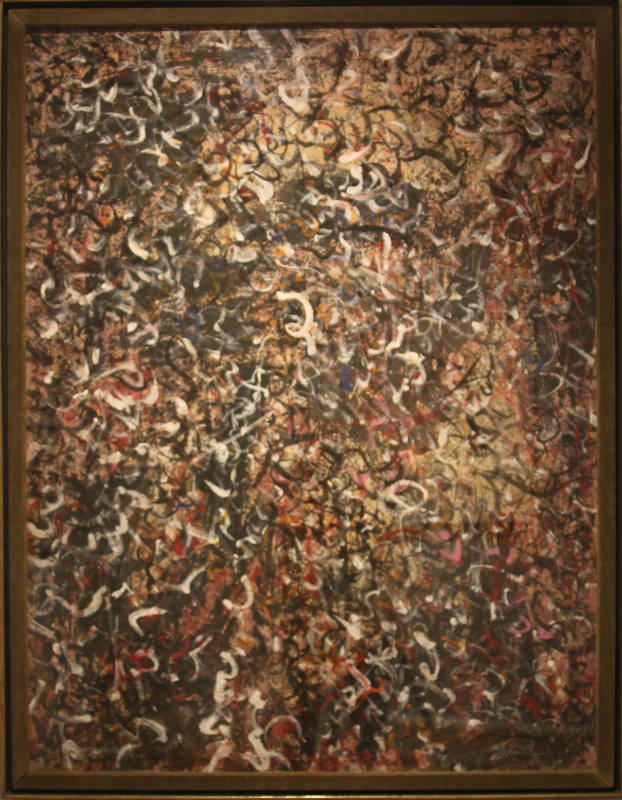Mark Tobey
American, 1890 - 1976
(not assigned)Basle, Switzerland
(not assigned)Chicago, Illinois, America
(not assigned)New York, New York, America
SchoolAbstraction
BiographyTobey was born in Centerville, Wisconsin on December 11, 1890. He studied briefly at the Art Institute of Chicago where he was first exposed to the work of artists such as Franz Hals, John Singer Sargent and also to the art of the Italian Renaissance. From 1911 to 1917, he worked in New York and Chicago as an illustrator for fashion magazines. Shortly thereafter he converted to the Bahai faith, the tenets of which would come to be central in his later work. He taught in England and the United States during the 1920s and 1930s, experimenting with various styles of painting such as Cubism. After his return to the United States in 1938, he began to use a style he called "white writing" in his paintings, in which he would paint in white over a richly colored abstract background. The end result resembled calligraphy and was considered by Tobey to be a reflection of universal spiritual themes. In 1960, Tobey left the United States permanently and settled in Basle, Switzerland. His paintings were well received in Europe, though he did not enjoy similar acclaim in the United States during his lifetime. He died in Basle on April 24, 1976. School: Abstraction
From Peggy Guggenheim website 6/23/2003
Mark Tobey (1890-1976)
Mark Tobey was born on December 11, 1890, in Centerville, Wisconsin. From 1906 to 1908 he attended Saturday classes at The Art Institute of Chicago. In 1911 Tobey moved to New York, where he worked as a fashion illustrator for McCaIl’s magazine. His first one-man show was held at M. Knoedler & Co., New York, in 1917.
In 1918 Tobey converted to the Bahà’i World Faith which led him to explore the representation of the spiritual in art. Four years later he moved to Seattle and began teaching at the Cornish School of Allied Arts. Also that year he began to explore Chinese calligraphy. The artist went to Paris in 1925, beginning his lifelong travels. While in the Middle East in 1926, he became interested in Persian and Arabic script. Upon returning to Seattle in 1928, Tobey confounded the Free and Creative Art School. From 1931 to 1938 he was resident artist at Dartington Hall, a progressive school in Devonshire, England. His tenure there was punctuated with frequent absences for travel to Mexico, the United States and the Orient. Tobey spent a month in a Zen monastery outside Kyoto in 1934; the following year he began his “white writing” paintings, which were shown for the first time at the Willard Gallery, New York, in 1944. Tobey exhibited regularly at the Willard Gallery thereafter.
Tobey returned in 1938 to Seattle where, in addition to painting and teaching, he studied the piano and music theory. During this period he executed several paintings inspired by Seattle’s open-air market. The Arts Club of Chicago held one-man shows of Tobey’s work in 1940 and 1946. Re was given a solo exhibition in 1945 at the Portland Museum of An, Oregon. In 1951, at the invitation of Albers, Tobey spent three months as guest critic of graduate art-students’ work at Yale University. Also that year the artist’s first retrospective was held, at the Palace of the Legion of Honor in San Francisco. A one-man show of Tobey’s work took place in 1955 at the Galerie Jeanne Bucher in Paris. The next year he was elected to the National Institute of Arts and Letters, and he received a Guggenheim International Award. In 1957 he began his Sumi ink paintings. Tobey was awarded the City of Venice painting prize at the Venice Biennale the following year. The artist settled in Basel in 1960, and in 1961 he became the first American painter to be honored with a one-man exhibition at the Musée des Arts Décoratifs in Paris. Solo presentations of Tobey’s work were held at The Museum of Modem Art, New York, in 1962, and at the Stedelijk Museum in Amsterdam in 1966. A major retrospective of the artist’s work took place at the National Collection of Fine Arts in Washington, D.C., in 1974. Tobey died in Basel on April 24, 1976.
Person TypeIndividual












